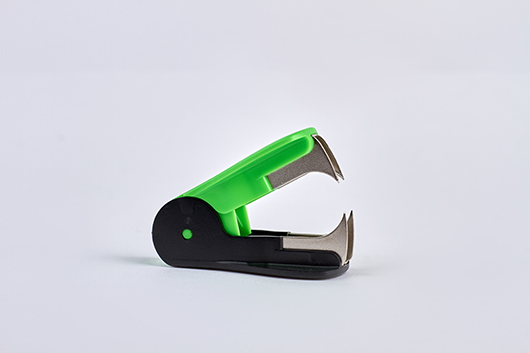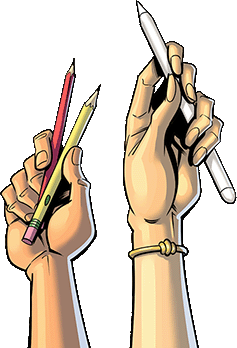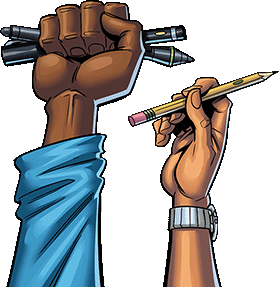How to Attach a Comic Book Cover
November 5, 2021
If you collect comic books, you may have come across one with a detached or loose cover. Reattaching the comic book’s cover can help it retain partial value and return it to a usable condition for other comic book connoisseurs.
Attaching comic book covers is part of a set of restoration techniques that protect damaged comics. Learn how to reattach a comic book cover along with the basics of comic book restoration.
What is Comic Book Restoration?
Comic book restoration is the practice of repairing and restoring damaged elements of comics to return them to their original state. This includes using various techniques to fix binding elements, reattach covers, touch up faded colors, fill in missing pieces, and clean dirty books.
Before the 1960s, people used crude reattachment methods. They used markers, pens, tape, and glue to fix damaged comics. William Sarrill shifted this trend in the 1970s when he opened The Restoration Lab, which focused on using professional paper restoration techniques on comics. These restored comics grew in value, making the business of comic book restoration a profitable endeavor.
Common Restoration Methods
The most commonly restored features on comic books are the color of the illustrations, missing paper, page tears, spine tears or breaks, weak spines or covers, and loose or detached covers. The following professional restoration techniques are used to address these areas of damage and restore the comic book:
Piece reattachment
If a comic book has loose pieces or pieces missing, the restorationist reattaches them with various adhesives. Reattachment is often necessary for missing areas on the bottom edge of a page.
If an entire cover is detached or loose, the restorationist may reattach it using staples for a staple bound book. They might also place an adhesive to reglue a loose cover on a perfect-bound book.
Piece filling
Piece filling uses rice paper, donor parts from comics made of the same material, or copy paper to reinstate the missing piece of the page.
Color touch up
The restorationist uses pens, crayons, markers, watercolors, or acrylic paint to mask color issues or replace missing color on the comics illustrations.
Spine and tear split sealing
In the case of a split or damaged spine or page tear on a comic book, a restorationist attempts to seal the tear using various adhesives. These could be rice paper, wheat paste, white glue, superglue, or wood glue.
Reinforcement
Reinforcement is usually needed to support the comic’s spine, staples, and cover area. Reinforcement consists of glue or rice paper bulking up the structure to support the area’s functionality.
Cleaning
Cleaning is common in comic book restoration. Several methods are used for cleaning comic books, including dry cleaning, solvent cleaning, and water cleaning. While not technically considered a restoration, dry cleaning is the safest method to use for non-professional cleaners.
Re-glossing
To restore lost sheen to a comic book cover, a restorationist uses a gloss spray to induce shine and create a protective layer.
Staple cleaning or replacement
The staple binding on some comics can become rusty, broken, or go missing. Restorationists remove old, dirty staples and clean them with the appropriate chemicals before putting them back. Alternatively, new or vintage staples may be used to rebind the book.

How to Attach a Comic Book Cover
The process for reattaching a comic book cover varies depending on the type of binding your comic book uses. Shorter comic books use saddle stitch, otherwise known as staple binding. This type of binding uses staples to hold 64 or fewer folded pages together in book form.
In this binding style, the binder folds the front and back cover, which are printed on one piece of paper, around the comic’s interior pages. They then push staples inward through the fold to hold the book together.
Comic books and graphic novels over 64 pages use square bound binding. These are also called perfect bound books. In this method, the binder gathers all the pages together and then glues the pages to the spine. The spine, front cover, and back cover are all one piece folded around the glued inner pages. The restorationist adds a thin layer of adhesive to the inside of the front and back covers along the spine to attach the covers completely.
Attaching a cover on saddle-stitch bound comics
To attach a cover to a comic book with staple binding, take the following steps:
- Open your comic to the centerfold and carefully remove original staples with a staple remover.
- If desired, clean staples with appropriate solutions for rust or dirt.
- Ensuring all the pages are in order, turn the comic over so the covers are on top. The back cover image should be on your left and the front cover image on your right.
- Using a saddle stapler that reaches to the center of the comic, place three staples on the spine. They should rest about 1” to 1.5” from the edge of the spine, with a third staple middle-distance between the two.
- Place the comic in the normal reading position and check for springiness. Gently use a paper folder to press down the fold.
If your comic book has rips or tears along the spine, use a restoration technique to make repairs after you remove the staples. Allow tears to mend, then proceed with replacing the staple binding. This makes for a much stronger restoration.
Attaching a cover on square bound comics
Attaching a cover back onto a square bound comic or graphic novel is a simple process. The basic attachment method uses special binding glue to reattach the cover to a perfect-bound book. Use a small, clean paintbrush to apply a thin layer of binding glue to whichever part needs reattaching.
For covers that are completely detached, start by gluing the spine to the page bundles. Apply gentle pressure until the glue is set.
Then, brush binding glue onto the very edge of the title page near the spine crease and the edge of the cover near the spine. Ideally, this glue layer will come out from the spine about ¼ inch. Do the same to the back cover, then place gentle pressure on the book overnight to ensure a good seal.
Comix Well Spring: Your Source for Comic Book Printing and Creation Information
Comix Well Spring: Your Source for Comic Book Printing and Creation Information
Comix Well Spring shares this love of comic books. We provide professional comic printing services for comic creators who self-publish their work. We also offer helpful articles on a wide range of comic creation topics, including how to create attention-grabbing comic book covers. Visit Comix Well Spring for all your comic book creation needs.


